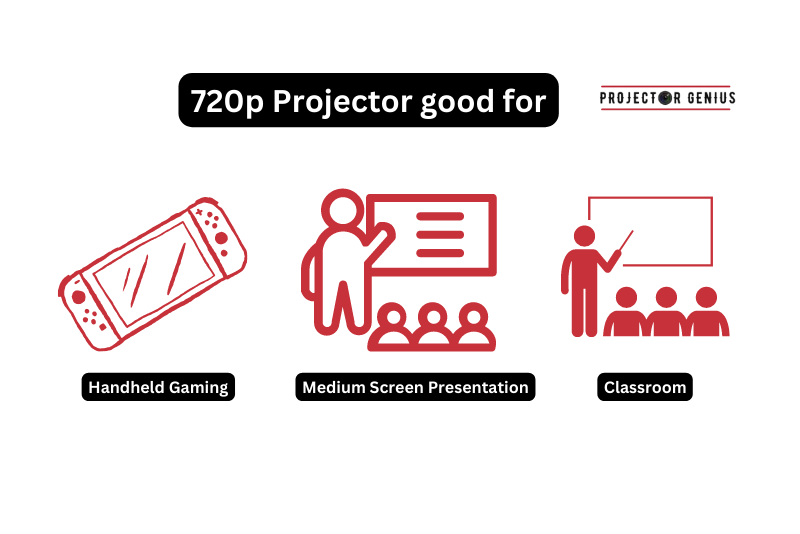720p vs 1080p: Which Should You Get In 2023?
-
 Written by:
Kristy Roger
Written by:
Kristy Roger
- Last Updated:
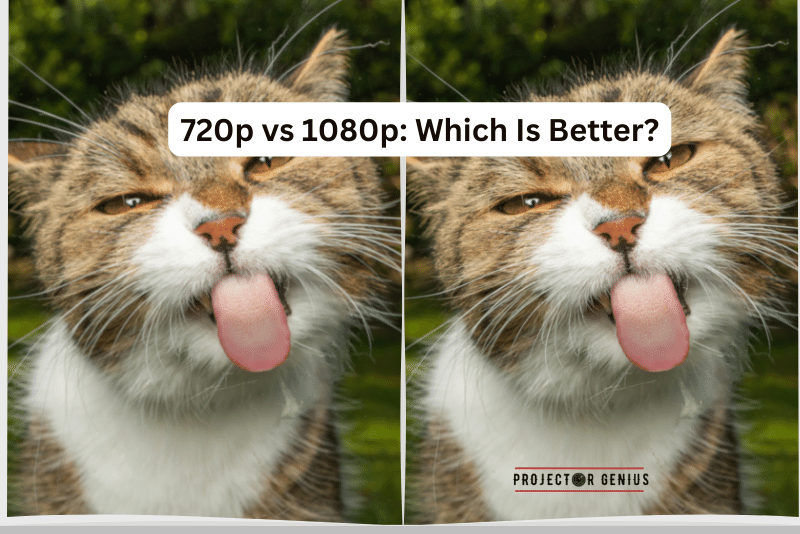
So, you’re wondering which is the best FHD(1080p) or HD(720p).
Throughout this article, I’ll talk you through the detailed knowledge of HD(720p) and FHD(1080p). I’ll also help you decide which Resolution works best for you.
720p vs 1080p projector? A 1080p projector offers higher resolution and delivers more detailed and sharper images than a 720p projector with a lower native resolution. If you want to experience superior image quality, especially for watching high-definition content or larger screen sizes, opting for a 1080p projector is the better choice.
I recommend using the Table of Contents to quickly access the information you need.
My article is designed to cater to home cinema users of all levels, from Beginners to Advanced enthusiasts.
Table of Contents
What is 720p and 1080p Resolution?
1080p and 720p are two different display resolutions commonly used for video content and displays:
720p
Also known as HD (High Definition) or HD Ready, 720p has a resolution of 1280×720 pixels. The “p” stands for “progressive scan,” meaning each frame is drawn in a sequence, creating a smoother and more natural image. 720p is widely used for HD content and is often found in TVs, computer monitors, and video streaming services.
1080p
Also known as Full HD (FHD), 1080p has a 1920 x 1080 pixels resolution. Like 720p, it uses progressive scan, but it offers a million pixel count, resulting in a sharper and more detailed image. 1080p is a standard resolution for high-definition content, such as Blu-ray movies, HD television broadcasts, and online streaming platforms.
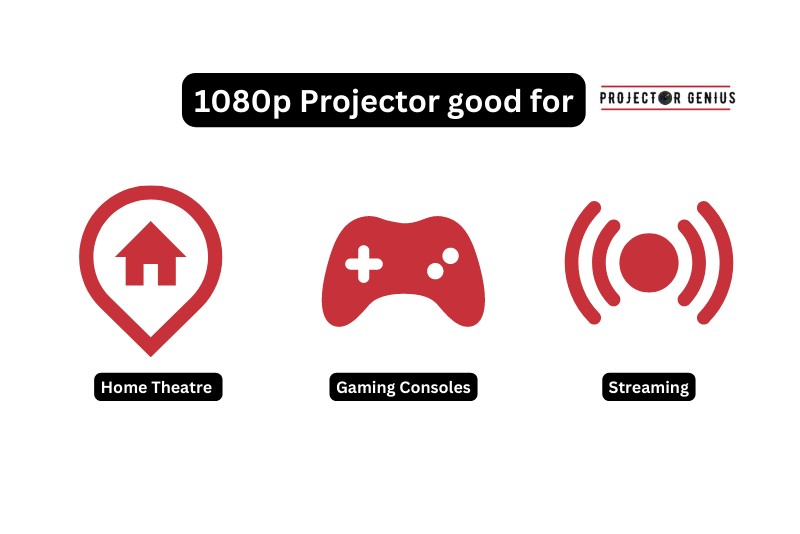
720p vs 1080p: What is the Difference Between 720p and 1080p Projectors?
The difference between 720p and 1080p projectors lies in their display resolutions and the level of detail they can produce in projected images:
Display Resolution
720p Projectors
These projectors have a resolution of 1280 x 720 pixels. They are capable of displaying high-definition content, but they have fewer pixels than 1080p projectors, resulting in a slightly lower level of detail in the projected image.
1080p Projectors
These projectors have a resolution of 1920 x 1080 pixels. With more pixels, they offer a higher level of detail and clarity in the projected image compared to 720p projectors. 1080p projectors are considered Full High Definition (FHD) and are widely used for high-quality home theater setups and professional presentations.
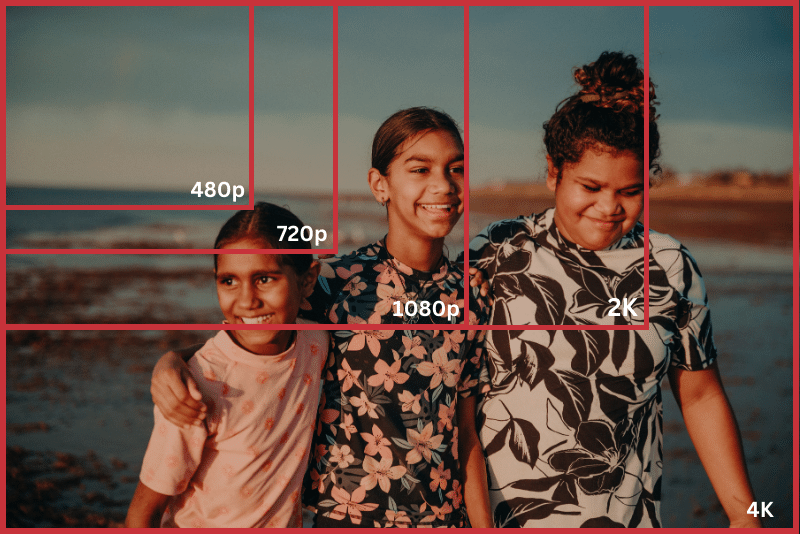
Image Quality
720p Projectors
While 720p projectors can provide good image quality, especially for smaller screens, they may not produce as sharp and detailed images as 1080p projectors, particularly on larger screens.
1080p Projectors
1080p projectors offer superior image quality, especially on larger screens. The additional pixels in the resolution result in clearer and more lifelike visuals, making them ideal for home theaters and situations where high image quality is crucial.
Content Compatibility
720p Projectors
720p projectors are still relevant for displaying HD content, such as Blu-ray movies and HD television broadcasts. They are a more budget-friendly option and can be suitable for casual home use or business presentations.
1080p Projectors
1080p projectors are compatible with a wider range of content, including Full HD movies, outdoor, gaming in higher resolutions, and professional presentations that demand greater visual clarity.
In summary, the main difference between 720p and 1080p projectors is the resolution and subsequent image quality. While both can be suitable for different applications, 1080p projectors generally provide a higher level of detail and are preferred for more demanding visual experiences like home theatre setups and professional presentations.
Which has Better Picture Quality: 720p or 1080p?
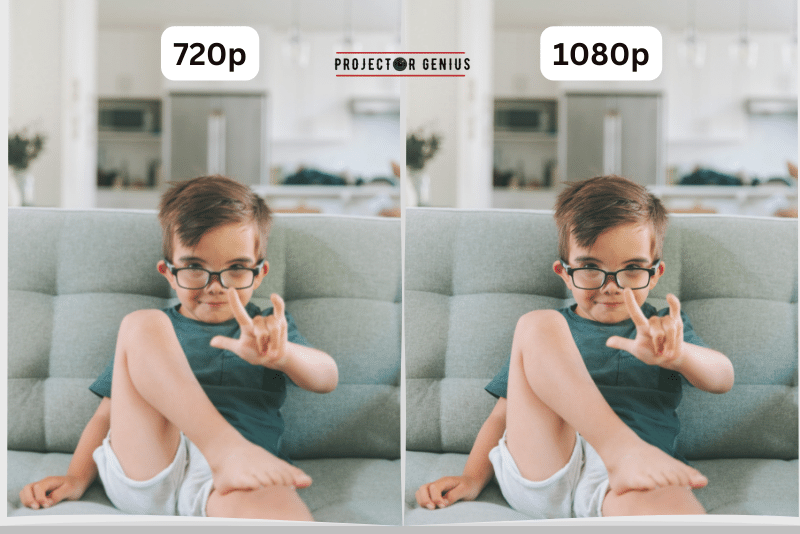
1080p has better image quality compared to 720p. The higher resolution of 1080p (1920 x 1080 pixels) provides more pixels and detail in the image compared to 720p (1280 x 720 pixels). As a result, 1080p offers sharper, clearer, and more detailed visuals, making it the superior choice for high-definition content and an overall better viewing experience.
The increased pixel count in 1080p allows for finer details to be displayed, enhancing the realism and immersion of the content. Whether you are watching movies, playing games, or engaging in professional presentations, 1080p provides a significant improvement in image quality over 720p.
In summary, 1080p has better image quality than 720p due to its higher resolution and ability to display more pixels, resulting in sharper and more detailed visuals. For a superior visual experience, 1080p is the preferred choice for viewing high-definition content on TVs, projectors, and other display devices.
How do these Projectors Handle Various Content Sources, Such as Streaming, Gaming, or Blu-ray Movies?
Both 720p and 1080p projectors can handle various content sources, including streaming, gaming, and Blu-ray movies. However, the difference in resolution can impact the overall visual quality and level of detail for each type of content:
Streaming
720p Projectors: 720p projectors can handle streaming content from platforms that offer HD streaming, such as Netflix, Hulu, or YouTube. The projector will downscale the content to fit its native resolution, and while it may not deliver the highest level of image quality, it can still provide a satisfactory viewing experience for streaming.
1080p Projectors: 1080p projectors are better equipped to handle streaming content, especially Full HD streams. The higher resolution allows for more detailed and clearer visuals, making the viewing experience more immersive. Streaming services that offer Full HD or even 4K content will be displayed at their native resolution on a 1080p projector.
Gaming
720p Projectors: For gaming, 720p projectors can handle console gaming and PC gaming with resolutions up to 720p. While the image may not be as detailed as on a 1080p projector, many games are designed to run smoothly at 720p and can still be enjoyable on a projector with this resolution.
1080p Projectors: 1080p projectors are well-suited for gaming, especially for consoles and PCs that support Full HD resolution. They can deliver sharper and more detailed graphics, leading to better gaming experiences overall.

Blu-ray Movies
720p Projectors: While 720p projectors can technically display Blu-ray movies, they will downscale the content to fit their native resolution. As a result, the image quality may not be as clear and detailed as it would be on a native 1080p projector.
1080p Projectors: 1080p projectors are designed to display Blu-ray movies at their native resolution, providing the highest level of image quality for Full HD content. Blu-ray movies will appear crisp and detailed on a 1080p projector, providing a cinematic experience.
Both 720p and 1080p projectors can handle various content sources, but the difference in resolution affects the level of detail and image quality for each type of content. While 720p projectors can provide satisfactory performance, especially for casual viewing and gaming, 1080p projectors offer a superior experience with sharper visuals, making them a preferred choice for high-definition content like Blu-ray movies and Full HD gaming.
Is the Visual Difference Noticeable Between 1080p and 720p Resolution?
Yes, the visual difference between 720p and 1080p is noticeable, especially when viewing content on larger screens or when comparing them side by side.
On larger screens, such as big TVs or projectors, the increased resolution of 1080p becomes more apparent. The higher pixel count in 1080p provides sharper and more detailed images, making the visuals appear clearer and more lifelike compared to 720p.
When comparing the same content in both resolutions side by side, you will likely notice that 1080p offers more fine details, improved clarity, and better overall image quality compared to 720p. This difference becomes more evident in scenes with intricate textures, small objects, or high-quality graphics.
However, the degree of noticeable difference also depends on the viewing distance. For smaller screens or when viewing from a distance, the difference may not be as striking as it would be on larger screens or when sitting closer to the display.
In summary, the visual difference between 720p and 1080p is noticeable, especially on larger screens and when comparing the resolutions side by side. 1080p offers superior image quality with more detail and clarity, making it the preferred choice for high-definition content and a more immersive viewing experience.
Cost Difference Between 720p and 1080p Projectors?
The cost difference between 720p and 1080p projectors can vary depending on the brand, model, features, and market conditions. Generally, 720p projectors are more budget-friendly compared to 1080p projectors. Here are some general observations regarding their cost difference:
- 720p Projectors: Since 720p projectors have a lower resolution and are considered to be a more basic entry-level option, they are typically more affordable. Prices for 720p projectors can range from a few hundred dollars to around a thousand dollars, depending on the brand and specifications.
- 1080p Projectors: 1080p projectors offer higher image quality and are considered to be more advanced and suitable for home theatre enthusiasts and professional presentations. As a result, they tend to be more expensive than 720p projectors. Prices for 1080p projectors typically start from around a thousand dollars and can go up to several thousand dollars for high-end models with advanced features.
Keep in mind that other factors, such as the projector’s brightness, contrast ratio, connectivity options, and additional features, can also influence the cost of both 720p and 1080p projectors. Additionally, market demand, availability, and sales promotions can also impact the pricing of projectors.
If you are looking for a budget-friendly option, a 720p projector may be suitable for basic home entertainment or business presentations. On the other hand, if you value higher image quality and enhanced viewing experiences, investing in a 1080p projector may be worth the extra cost.
Can a 1080p Projector Display 720p Content?
Yes, a 1080p projector can display 720p content without any issues. In fact, 1080p projectors are designed to be backward compatible with lower resolutions, including 720p, 480p, and others.
When you play 720p content on a 1080p projector, the projector will automatically downscale the content to match its native resolution (1080p). Downscaling means the projector will adjust the image to fit the lower resolution while maintaining the correct aspect ratio and preserving the overall visual quality as much as possible.
Since 1080p has more pixels than 720p, downscaling from 720p to 1080p does not result in any loss of image quality. The projected image will still appear sharp and clear, and you will be able to enjoy your 720p content without any noticeable degradation.
In summary, a 1080p projector can easily handle and display 720p content, making it compatible with a wide range of video format sources and ensuring a smooth viewing experience regardless of the content’s resolution.
Is Upgrading to 1080p Worth It?
Deciding whether upgrading to 1080p is worth it depends on your specific needs, preferences, and existing setup. Here are some factors to consider:
- Content and Usage: If you frequently watch high-definition content, such as Blu-ray movies, HD streaming services, or play modern video games, upgrading to 1080p can significantly enhance your viewing experience. 1080p offers higher image quality and more detailed visuals, especially on larger screens.
- Screen Size: If you have a larger TV, projector, or monitor, the benefits of 1080p resolution will be more noticeable. On larger screens, the increased pixel count in 1080p delivers a clearer and more immersive image compared to lower resolutions like 720p.
- Budget: Upgrading to a 1080p display or projector may come with additional costs compared to sticking with your existing setup. Consider your budget and whether the benefits of higher resolution justify the expense.
- Content Availability: Ensure that the content you frequently watch or play is available in 1080p. While many modern media sources offer HD content, some older content or platforms may be limited to lower resolutions.
- Device Compatibility: Check if your devices, such as gaming consoles, streaming devices, or media players, support 1080p resolution. Upgrading to 1080p may require compatible hardware to fully utilize the higher resolution.
- Viewing Distance: If you typically sit far away from your screen, the difference between 1080p and lower resolutions may be less noticeable. In such cases, a 720p display might suffice.
Upgrading to 1080p can be worth it if you value enhanced image quality, watch a lot of HD content, have a larger screen, and have the budget for the upgrade. However, if your current setup meets your needs and you don’t prioritize top-tier image quality, sticking with your existing setup might be more practical. Consider your viewing habits, device compatibility, and budget to make an informed decision about whether upgrading to 1080p is worth it for you.
How Does the Brightness and Colour Performance Differ Between 720p and 1080p Projectors?
The brightness and colour performance of 720p and 1080p projectors can vary based on their individual specifications and technology. In general, the differences in brightness and colour performance between the two resolutions may not be directly tied to the resolution itself but more to the quality and features of the specific projector models. Here are some key points to consider:
Brightness
– Brightness is measured in lumens, and projectors are rated for their brightness output. Both 720p and 1080p projectors can have a wide range of brightness levels, from entry-level models to high-end projectors with greater brightness capabilities.
– In most cases, a higher brightness rating can help with better visibility in well-lit rooms or larger screens. However, this is not directly tied to the resolution but to the projector’s overall brightness specifications.
Colour Performance
– Colour performance is influenced by various factors, such as the projector’s colour processing, Colour reproduction technology (e.g., LCD, DLP), and the Colour accuracy of the display.
– High-quality projectors, regardless of their resolution, are designed to provide accurate and vibrant Colours. Some high-end 1080p projectors may offer better Colour accuracy and wider Colour gamuts than entry-level 720p projectors, but it is not a direct result of the resolution.
Image Processing
– Advanced image processing technologies, such as HDR (High Dynamic Range) and advanced Colour calibration, can greatly impact the Colour performance and dynamic range of the projected image.
– While 1080p projectors may support some advanced image processing features, the availability of such features can also be found in certain high-quality 720p projectors.
In summary, the brightness and Colour performance of projectors is influenced by various factors beyond resolution. High-quality projectors, whether 720p or 1080p, can provide excellent brightness and Colour performance. When comparing projectors, it is crucial to consider their specific specifications, technology, and reviews to determine their overall performance, rather than focusing solely on the resolution.
Can a 720p Projector Display 1080p Content?
Yes, a 720p projector can display 1080p content, but with some limitations. When you play 1080p content on a 720p projector, the projector will downscale the image to match its native resolution of 720p (1280 x 720 pixels).
Downscaling means that the projector will compress the higher resolution (1080p) image to fit its lower resolution (720p) display. As a result, some of the finer details and clarity present in the original 1080p content may be lost during the downscaling process.
The downscaled image will still be viewable, but it won’t provide the same level of sharpness and detail as when displayed on a native 1080p projector.
In summary, a 720p projector can accept and display 1080p content, but the image will be downscaled to fit its lower resolution. While it can be a convenient way to watch 1080p content on a 720p projector, it won’t deliver the full visual quality and detail that a native 1080p projector would provide. If you prioritize high-definition content and want to experience it at its best, consider investing in a 1080p projector for optimal viewing quality.
When to Prefer a 720p Projector?
You may prefer a 720p projector in the following situations:
- Budget Constraints: If you have a limited budget and are looking for a more affordable projector option, a 720p projector can be a cost-effective choice. They tend to be less expensive than 1080p projectors, making them accessible to a wider range of consumers.
- Casual Viewing: If you mainly use the projector for casual viewing, such as watching standard-definition content, TV shows, or playing casual games, a 720p projector can provide satisfactory image quality. For less demanding content, the difference in resolution may not be as noticeable.
- Smaller Screen Size: If you plan to use the projector on a smaller screen or in a space with limited viewing distance, a 720p resolution can still offer a decent viewing experience without significant loss of detail.
- Lower Bandwidth: If you have limited internet bandwidth or data restrictions, streaming content in 720p requires less data compared to streaming in 1080p, making it a practical choice for conserving data usage.
- Business Presentations: For basic business presentations or educational purposes, a 720p projector can serve the purpose well, especially if the content doesn’t require high-definition visuals.
- Backyard Movie Nights: If you plan to use the projector for outdoor movie nights or events, a 720p projector can be a suitable and portable option that still delivers an enjoyable viewing experience.
In summary, a 720p projector is preferable when you are on a budget, have lower-resolution content, or are looking for a more budget-friendly option for casual viewing or basic presentations. It can still provide decent image quality and serve your needs, especially in situations where the higher resolution of a 1080p projector may not be necessary.
Are There Differences in Screen Size or Distance Requirements for 720p and 1080p Projectors?
The choice between a 720p and 1080p projector can affect the optimal screen size and viewing distance requirements. Here are the key differences to consider:
Screen Size
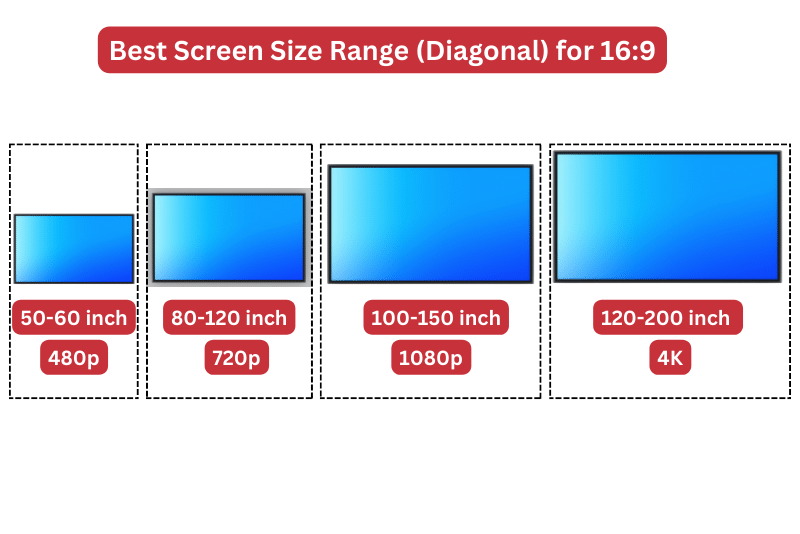
720p Projector
A 720p projector is generally better suited for smaller screens, as the lower resolution may not provide the same level of detail and sharpness on larger screens. For smaller screens, such as up to 100 inches diagonal, a 720p projector can still deliver a satisfactory viewing experience.
1080p Projector
A 1080p projector is more suitable for larger screens, especially those exceeding 100 inches diagonal. The higher resolution allows for more pixels and detail, resulting in a clearer and more immersive image on larger screens. If you plan to project onto a large screen or desire a more cinematic experience, a 1080p projector would be a better choice.
Viewing Distance
720p Projector
With a 720p projector, the optimal viewing distance is generally closer to the screen. If you sit too far back from the screen, you may start to notice individual pixels, reducing the overall image quality. For smaller screens or intimate viewing spaces, a 720p projector can work well.
1080p Projector
A 1080p projector allows for a more flexible viewing distance due to its higher resolution. You can sit farther away from the screen without sacrificing image quality. This makes 1080p projectors ideal for larger rooms or setups where viewers may be seated at a variety of distances from the screen.
In summary, the choice between a 720p and 1080p projector can impact the optimal screen size and viewing distance requirements. For smaller screens and closer viewing distances, a 720p projector can suffice and provide a satisfactory experience.
However, for larger screens and more versatile viewing distances, a 1080p projector is recommended to ensure better image quality and clarity. Consider your viewing space, seating arrangements, and desired screen size when deciding which resolution best suits your needs.
Can a 720p Projector Upscale to 1080p Effectively?
A 720p projector does not have the ability to effectively upscale content to 1080p.
It can only display content at its native resolution of 720p, and attempting to send 1080p content to a 720p projector will result in downscaling, reducing the image quality rather than improving it.
If you want to enjoy true 1080p resolution, you will need to use a native 1080p projector or a display device capable of upscaling to 1080p effectively.
What are the Connectivity Options and Compatibility Differences Between 720p and 1080p Projectors?
The connectivity options and compatibility differences between 720p and 1080p projectors are generally similar, as they both support common video and audio connections. However, some higher-end 1080p projectors may offer additional features or connectivity options that are not found in entry-level 720p projectors. Here are the standard connectivity options and potential differences:
1. Video Inputs
– Both 720p and 1080p projectors typically come with standard video inputs, such as HDMI, VGA, and composite video (RCA). These inputs allow you to connect various devices, including computers, gaming consoles, Blu-ray players, and media streaming devices.
2. HDMI
– HDMI is the most common and important video connection for projectors. Both 720p and 1080p projectors usually have HDMI ports. HDMI is capable of transmitting high-definition audio and video signals in a single cable.
3. VGA
– VGA is an older video connection commonly found on projectors and computers. It can support lower resolutions, including 720p, but it may not provide the full resolution and image quality of 1080p.
4. Audio Outputs
– Many projectors have built-in speakers, but they may not offer the best audio quality. Both 720p and 1080p projectors typically have audio output options, like 3.5mm audio jacks, to connect external speakers or sound systems for better audio performance.
5. Wireless Connectivity
– Some higher-end 1080p projectors may offer wireless connectivity options, like built-in Wi-Fi or Bluetooth. These features allow you to wirelessly stream content from compatible devices, such as smartphones, tablets, or laptops.
6. MHL (Mobile High-Definition Link)
– MHL is a technology that allows you to connect mobile devices to the projector via the HDMI port. Some projectors, both 720p, and 1080p, support MHL, which can be useful for displaying content from smartphones and tablets.
In summary, both 720p and 1080p projectors have standard video inputs like HDMI, VGA, and composite video, and they offer similar connectivity options. However, some higher-end 1080p projectors may have additional features like wireless connectivity or MHL support, providing more versatility and compatibility with modern devices. If specific connectivity options are crucial for your setup, it’s essential to check the specifications of the projector model you are considering.
How does the Resolution Impact the Power Consumption and Lamp Life of the Projector?
The resolution of a projector can impact power consumption and lamp life, but the relationship is not directly tied to the resolution alone. Other factors, such as the projector’s technology, brightness level, and image processing, also play significant roles. Here’s how resolution can influence power consumption and lamp life:
Power Consumption
Higher-resolution projectors (e.g., 1080p) may require more processing power and higher-quality components to handle the increased number of pixels. As a result, they may consume slightly more power than lower-resolution projectors (e.g., 720p).
However, the difference in power consumption between 720p and 1080p projectors is generally not substantial and may vary between different models. The brightness level, display technology (LCD, DLP, etc.), and other features have a more significant impact on power consumption.
Lamp Life
Lamp life is affected by several factors, and resolution is just one of them. The brightness setting and usage patterns have more significant impacts on lamp life than resolution alone.
In some cases, higher-resolution projectors may have more advanced technologies that can optimize lamp usage, resulting in similar or even longer lamp life compared to lower-resolution projectors. These technologies might include eco modes, automatic brightness adjustment, or power-saving features.
It’s essential to consider the overall specifications and features of the projector, not just its resolution when evaluating power consumption and lamp life. Additionally, advancements in projector technology have led to improvements in energy efficiency and lamp longevity across various resolutions.
In summary, while resolution can have some influence on power consumption and lamp life, the difference between 720p and 1080p projectors is not significant. Other factors like brightness level, display technology, and projector features play more substantial roles in determining power usage and lamp longevity. When choosing a projector, it’s crucial to consider the entire package of features and specifications to make an informed decision.
Final Thoughts
Ultimately, the best choice between 720p and 1080p projectors is one that aligns with your budget, viewing preferences, and the content you most frequently enjoy. With the right projector, you can transform your viewing space into a captivating and immersive entertainment hub or a powerful tool for business presentations and education.
Author of this Post:

Kristy Roger
Home Cinema Consultant & Tech Enthusiast
Holding a background in Industrial and Electrical Technology from the University of Alberta, Kristy has spent 5+ years consulting on home theater products at a top electronics firm. As a certified Technical Professional with Lean Six Sigma credentials, Kristy expertise ranges from projector nuances to hands-on experience with leading models. Kristy have been sharing her knowledge online for two years, blending professional insights with personal experiences from her own home cinema setup. Off the screen, She is a dedicated mom to Jerry, Ryan, and our two pups, Cuddle and Paw.

